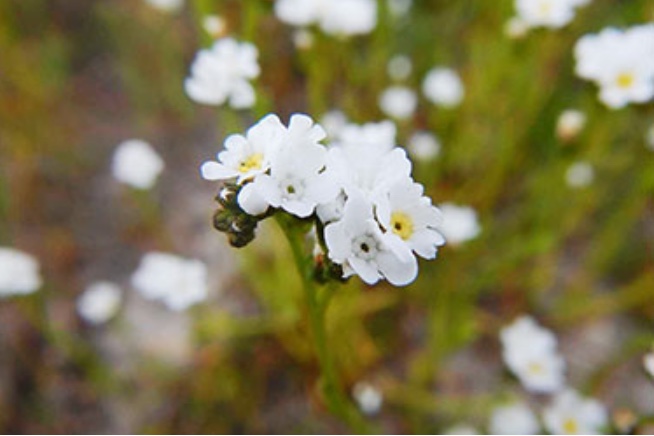
Calistoga Popcorn Flower; photo from the Pacific Union College website
For three months of the year, two small fields in the popular Napa Valley resort town of Calistoga blossom with tiny white flowers known as the Calistoga Popcorn Flower. These two fields are the only known location of this flower in the world, which explains its presence on the list of endangered plants.
“There’s a PUC alumnus in Calistoga doing a housing project, and he asked me to come take a look at this flower,” says Aimee Wyrick, chair of the department of biology at Pacific Union College. “I did, and I’ve been looking for six years now.”
During those years, Wyrick has worked determinedly during blossom season, collecting soil and water samples for examination in a lab.
“What’s clear is where this flower is found has a lot to do with what’s in the soil,” Wyrick says. “But we haven’t really been able to dig into this idea until recently.”
What changed was the arrival of Kirpa Batth, a biochem major from Sacramento, California, who enrolled in PUC’s honors program with an interest in hands-on research. When offered the opportunity to partner with Wyrick and Robert Wilson, chemistry professor, Batth jumped at the chance.
“Though we’re still in the early stages of our research, we have determined one thing,” Batth explains. “There is a high concentration of heavy metals in the soil; specifically boron, magnesium, and calcium.”
Typically, plants shouldn’t be able to survive with metals in the soil at the levels at which Batth and Wyrick have found.
“What we need to figure out is if there are X units in the soil, how much does the plant have, and how does that relate to the water in the soil,” says Wyrick. “Once the methodology is set up and we have a hint at this relationship, we can take more samples and see it on a landscape scale.”
Testing with a New Machine
To get these results, Batth is using a brand new machine, recently purchased with the help of two generous donors for the department of chemistry. The Microwave Plasma Atomic Emission Spectrometer (MPAES) can measure the amount of over 60 elements in many types of samples, and is sensitive enough to detect one part in a billion.
The trick, though, is virtually no one has ever used the MPAES in the way Batth and Wyrick are trying to use it.
“I have spent months with Dr. Wilson, researching literature explaining how to do anything close to what we’re trying to do,” says Batth. “Not many people use this machine for plants. There is almost nothing out there on what we’re doing. We’re kind of blazing a new trail here.”
Another challenge to the research is the endangered nature of the plant. In order to study the flower, Wyrick needs special permission from the California Department of Fish & Wildlife in order to remove samples, and those are strictly limited, as well. Wyrick is required to record and report whatever she collects.
“Because our sampling is so limited, we’re figuring out a testing method with other, more common, plants before we test the method on the species we’re studying,” Wrick explains. “We have to determine if the MPAES can pick up what we want it to before we test one of our invaluable and limited specimens.”
One thing the test runs have revealed is the researchers need specific glassware, as there can be trace elements of the substances they’re looking for in the glass, which will affect and skew test results.
“It’s really cool Kirpa joined the project,” Wyrick says. “We had great intentions, and she has really made the project take off. The bridge between the sciences is awesome enough, but to have the additional piece of her being an honors student is really neat.”
Plant Products
So once they understand the environment in which the Calistoga Popcorn Flower thrives, what’s next?
“Knowing more, we could be able to restore its population and grow it,” Wyrick explains. “Most likely it will have to be very close to where it already is because you don’t want to remove a plant from where it grows natively, but we could help augment its population.”
Additionally, because these plants grow in such unexpectedly adverse conditions, Wyrick hopes they can learn something about their resiliency that can help other threatened plants.
“These plants live for a short amount of time in geothermal water,” she points out. “They’re pushing the boundaries. As we see organisms around the world starting to be pressed in by difficult situations, it’s amazing to see some already facing those challenges. Maybe we can learn something from them.”
Understanding the plant isn’t the only goal of the project, though. Part of the research outcomes are the methods.
“They don’t exist currently,” Wyrick states. “Learning how to do this for our specific project will make this method available for researching other endangered species. Simply figuring that out is publishable, but the work she’s doing with the plant offers a broader implication of the work Kirpa has done.”
Though Batth has been passionate about becoming a doctor for as long as she can remember, this project, paired with other lab courses she’s taken, have piqued her interest in biochemistry. She is currently considering a possible future as a forensic biochemist, but is keeping her options open as she explores ideas for her future.
Departmental collaboration is an added benefit of this project, as well.
“Some schools get territorial by department,” Wyrick says. “Here it just feels like we’re all scientists. For decades, the chairs of the science departments have met biweekly meetings, and everyone is so willing to work together. I hope to see more of what Kirpa is doing bridging us even more.”
— This article originally appeared on the Pacific Union College website on July 18, 2018.
